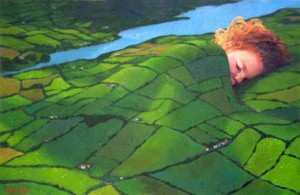On June 16 every year, millions of James Joyce aficionados around the globe flock to hear readings of their favorite Joyce work, “Ulysses,” which chronicles a day in the life of a Dublin man, Leopold Bloom. And Bloomsday is no ordinary day in Philadelphia either. After all, the city’s Rosenbach Museum houses a copy of Joyce’s original manuscript of the novel, which was widely banned in its day and continues to flummox college literature majors with its highly stylized form and language. This is not beach reading, folks.
But Joyce fans are like Deadheads (fans of The Grateful Dead, not Joyce’s short story, “The Dead)”: They love this book, possibly enough to camp out to get the best seat at the readings.
That said, there’s something for everyone in the city’s celebration of this literary landmark. You don’t even have to know how to read to go on a pub crawl. But to help you get up to speed, Fergie’s Pub at 1214 Sansom Street (owner Fergus Carey is a perennial reader at Bloomsday) is sponsoring a Bloomsday 101 at 6 PM on Friday, June 15, before sending you off for a pint at their bar or the following fine establishments with Bloomsday specials:
Irish Pub
1123 Walnut Street
$2.00 pints of Miller, Miller Lite, Bud, Bud Lite
$2.50 mixed well drinks
Nodding Head
1516 Sansom Street
Reasonably priced and great fries!
McGlinchey’s
259 S. 15 th Street (corner of 15th and Manning, between Spruce and Locust Streets)
20 oz. mugs of Rolling Rock for $2.35
By then you should have boned up on another Joyce classic, the aforementioned short story, “The Dead,” from the book, “Dubliners. ” On Wednesday evening, June 13, at the Union League, 140 South Broad Street, barrister Brendan Kilty, who owns and has restored 15 Usher’s Island in Dublin–the setting for the story–will discuss the 1987 John Huston film version of “The Dead,” which will be screened following cocktails and hors d’oeuvres at 5:30 PM. Cost is $40. RSVP to Katelyn at 215-546-9422 or email her at katelyn@expertevents.com.
Kilty will also appear at a free screening of the film at 2 PM Friday, June 15, at The City Institute Library at 1905 Locust Street on Rittenhouse Square. No cocktails and hors d’oeuvres at this one.
On the day itself (Saturday, June 16), readers from all walks of life, including local TV personalities, politicians, and at least one publican, will read selections from “Ulysses” at the Rosenbach Museum and Library, 2008-2010 Delancey Place, starting at noon and going on into the evening. Rain location is First Unitarian Church of Philadelphia, 2125 Chestnut Street. For more information, call 215-732-1600, email info@rosenbach.org, or visit the website at www.rosenbach.org. The Rosenbach will also be exhibiting selections from the original “Ulysses” manuscript; the museum will open at 12 PM.
You’ll be “tirsty” after all of this literature, so head over to McGillin’s Olde Ale House at 1310 Drury Street where on Saturday night they’ll be having live music by Baby Brother and the High Five and offering a free beer to anyone carrying a book by Joyce with them. There will be no pop quizzes.


